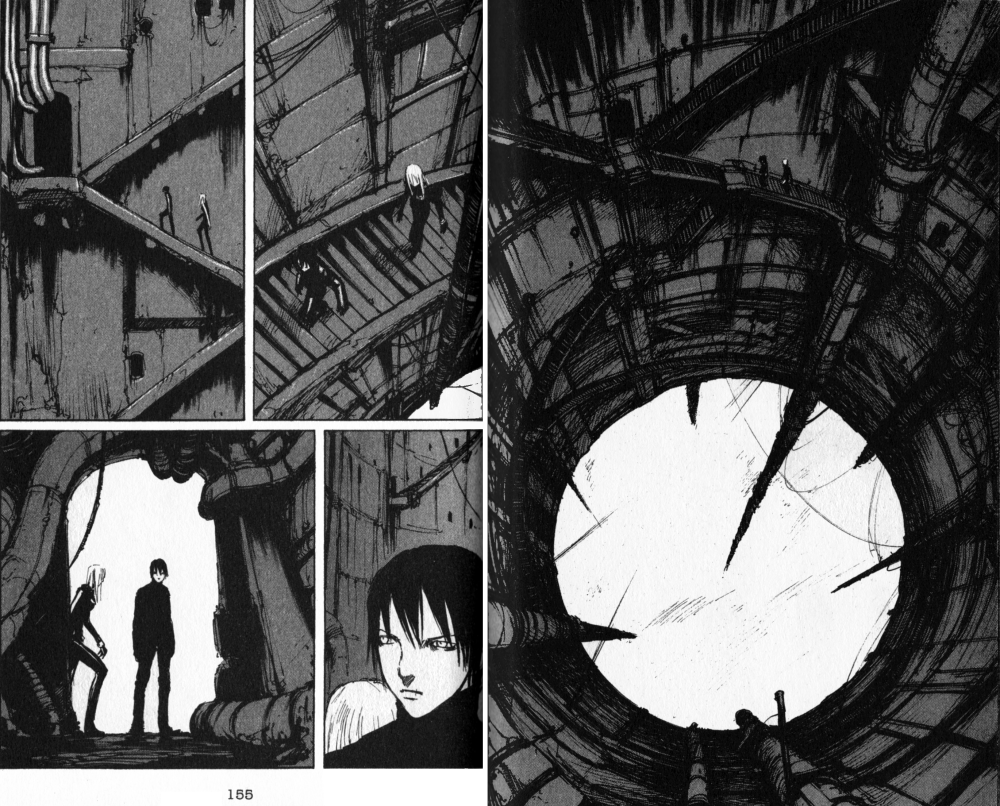 Planetes is the story of Hachirota Hoshino, dubbed “Hachimaki” by his crewmates for his propensity to wear a headband (hachimaki), who dreams of earning enough fame and fortune to buy his own spaceship and achieve complete freedom. As the series begins, however, he’s part of a crew of “extraplanetary sanitation workers” who clean up space debris.
Planetes is the story of Hachirota Hoshino, dubbed “Hachimaki” by his crewmates for his propensity to wear a headband (hachimaki), who dreams of earning enough fame and fortune to buy his own spaceship and achieve complete freedom. As the series begins, however, he’s part of a crew of “extraplanetary sanitation workers” who clean up space debris.
The first volume introduces readers to the crew of The Toy Box. In addition to Hachimaki, there’s Yuri, a Russian of indeterminate age whose perpetual staring into space (literally!) is explained when the story of his wife’s demise in a space liner crash is revealed. Yuri achieves some closure in the first chapter, when he finally finds a compass that was precious to his wife, and becomes a livelier character (and occasional font of wisdom) from then on. Tomboyish pilot Fee is a Floridian with a family back home and an ardent passion for cigarettes, which prompts her to go after some environmental terrorists who’re going around bombing smoking lounges.
 The environmental terrorists become a more important factor in volume two. Hachimaki, who has been somewhat of a slacker up until now, learns that a rich inventor is mounting an expedition to Jupiter. Hachimaki develops a single-minded determination to be on the Jupiter mission, which leads to him working out endlessly and being sort of an ass to Tanabe, the (female) newcomer to the crew set to be his replacement. The environmental group—the Space Defense League—attempts several times to sabotage the protect, since the purpose of the mission to Jupiter is not exploration but to mine its resources. Hachimaki isn’t particular about the reasons—he just wants to go—and when his former friend, Hakim is revealed to be the terrorist mastermind, Hachimaki nearly kills him, saved at the last minute by Tanabe.
The environmental terrorists become a more important factor in volume two. Hachimaki, who has been somewhat of a slacker up until now, learns that a rich inventor is mounting an expedition to Jupiter. Hachimaki develops a single-minded determination to be on the Jupiter mission, which leads to him working out endlessly and being sort of an ass to Tanabe, the (female) newcomer to the crew set to be his replacement. The environmental group—the Space Defense League—attempts several times to sabotage the protect, since the purpose of the mission to Jupiter is not exploration but to mine its resources. Hachimaki isn’t particular about the reasons—he just wants to go—and when his former friend, Hakim is revealed to be the terrorist mastermind, Hachimaki nearly kills him, saved at the last minute by Tanabe.
Hachimaki makes the crew for the Jupiter mission and by volume three is participating in mission training simulations. He’s haggard, though, losing weight, having visions of some sort of mystical cat, and feeling disconnected from everything around him. His crewmate, Sally, attempts to get through to him, and eventually succeeds (via boob therapy). Hachimaki has spent a great deal of time pursuing solitude, but Sally makes him see that in the end that Tanabe was right all along—“space is too dangerous and wonderful a thing to face alone.” Like his father before him, Hachimaki marries before heading out into space in order to anchor himself with a home.
 Planetes is definitely an interesting tale, offering a mixture of science fiction and philosophizing about what it means for humans to go into space. One might notice, though, that in each of the paragraphs above dedicated to a particular volume of the series, Hachimaki seems like a different person. And, indeed, an inability to identify with the lead is what prevented me from awarding these volumes an “A.”
Planetes is definitely an interesting tale, offering a mixture of science fiction and philosophizing about what it means for humans to go into space. One might notice, though, that in each of the paragraphs above dedicated to a particular volume of the series, Hachimaki seems like a different person. And, indeed, an inability to identify with the lead is what prevented me from awarding these volumes an “A.”
These volumes take place between 2074 and 2077, and it makes sense that a person could change a great deal in that time, especially given what Hachimaki has experienced, but sometimes I couldn’t trace the path between one incarnation of Hachimaki and the next or fully buy into his feelings for Tanabe. Also, even though it would have been unfortunate if Hachimaki had remained on the debris-collecting crew forever, I really missed Yuri and Fee as the story moved away from them. The first volume may be the most episodic of the first three, but it’s also a little less heavy than the others.
Ultimately, I liked Planetes a lot, though it wasn’t a quick read for me. I’m looking forward to the fourth and final volume.
Planetes is published in English by TOKYOPOP. There are technically five books in this series, but the last two comprise volume four, which was split due to length.
Additional reviews of Planetes can be found at Triple Take.




















Recent Comments